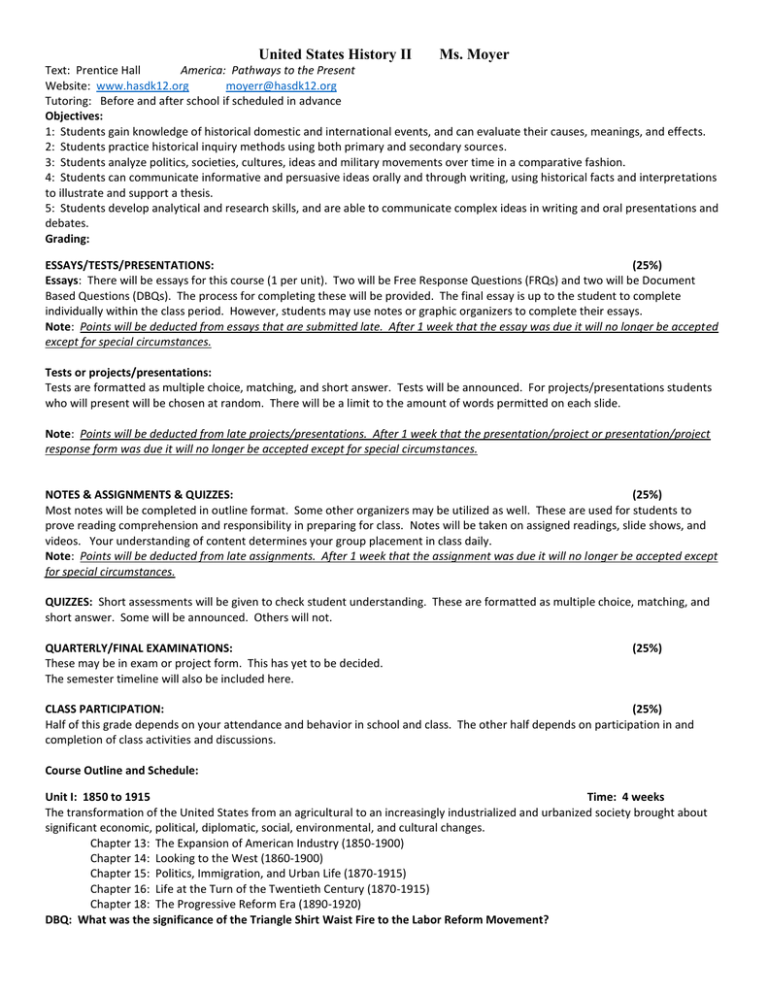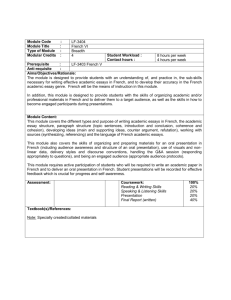United States History II Ms. Moyer
advertisement

United States History II Ms. Moyer Text: Prentice Hall America: Pathways to the Present Website: www.hasdk12.org moyerr@hasdk12.org Tutoring: Before and after school if scheduled in advance Objectives: 1: Students gain knowledge of historical domestic and international events, and can evaluate their causes, meanings, and effects. 2: Students practice historical inquiry methods using both primary and secondary sources. 3: Students analyze politics, societies, cultures, ideas and military movements over time in a comparative fashion. 4: Students can communicate informative and persuasive ideas orally and through writing, using historical facts and interpretations to illustrate and support a thesis. 5: Students develop analytical and research skills, and are able to communicate complex ideas in writing and oral presentations and debates. Grading: ESSAYS/TESTS/PRESENTATIONS: (25%) Essays: There will be essays for this course (1 per unit). Two will be Free Response Questions (FRQs) and two will be Document Based Questions (DBQs). The process for completing these will be provided. The final essay is up to the student to complete individually within the class period. However, students may use notes or graphic organizers to complete their essays. Note: Points will be deducted from essays that are submitted late. After 1 week that the essay was due it will no longer be accepted except for special circumstances. Tests or projects/presentations: Tests are formatted as multiple choice, matching, and short answer. Tests will be announced. For projects/presentations students who will present will be chosen at random. There will be a limit to the amount of words permitted on each slide. Note: Points will be deducted from late projects/presentations. After 1 week that the presentation/project or presentation/project response form was due it will no longer be accepted except for special circumstances. NOTES & ASSIGNMENTS & QUIZZES: (25%) Most notes will be completed in outline format. Some other organizers may be utilized as well. These are used for students to prove reading comprehension and responsibility in preparing for class. Notes will be taken on assigned readings, slide shows, and videos. Your understanding of content determines your group placement in class daily. Note: Points will be deducted from late assignments. After 1 week that the assignment was due it will no longer be accepted except for special circumstances. QUIZZES: Short assessments will be given to check student understanding. These are formatted as multiple choice, matching, and short answer. Some will be announced. Others will not. QUARTERLY/FINAL EXAMINATIONS: These may be in exam or project form. This has yet to be decided. The semester timeline will also be included here. (25%) CLASS PARTICIPATION: (25%) Half of this grade depends on your attendance and behavior in school and class. The other half depends on participation in and completion of class activities and discussions. Course Outline and Schedule: Unit I: 1850 to 1915 Time: 4 weeks The transformation of the United States from an agricultural to an increasingly industrialized and urbanized society brought about significant economic, political, diplomatic, social, environmental, and cultural changes. Chapter 13: The Expansion of American Industry (1850-1900) Chapter 14: Looking to the West (1860-1900) Chapter 15: Politics, Immigration, and Urban Life (1870-1915) Chapter 16: Life at the Turn of the Twentieth Century (1870-1915) Chapter 18: The Progressive Reform Era (1890-1920) DBQ: What was the significance of the Triangle Shirt Waist Fire to the Labor Reform Movement? Unit II: 1870 to 1945 Time: 5 weeks An increasingly pluralistic United States faced profound domestic and global challenges, debated the proper degree of government activism, and sought to define its international role. Chapter 17: Becoming a World Power (1890-1915) Chapter 19: The World War I Era (1914-1920) Chapter 20: Postwar Social Change (1920-1929) Chapter 21: Politics and Prosperity (1920-1929) Chapter 22: Crash and Depression (1929-1933) Chapter 23: The New Deal (1933-1941) Chapter 24: World War II: The Road to War (1931-1941) Chapter 25: World War II: Americans at War (1941-1945) FRQ Choices: A. Analyze the influence of the Treaty of Versailles on the events that led to the start of World War II. B. Analyze the use of the Atomic Bomb by the United States against Japan in World War II from political, ethical, and military perspectives. C. Assess the effectiveness of Franklin D. Roosevelt’s New Deal programs on ending the Great Depression, as well as the effect they have on the economy today. Unit III: 1945 to 1981 Time: 4 weeks After World War II, the United States grappled with prosperity and unfamiliar international responsibilities, while struggling to live up to its ideals. Chapter 26: The Cold War (1945-1960) Chapter 27: The Postwar Years at Home (1945-1960) Chapter 28: The Civil Rights Movement (1950-1968) Chapter 29: The Kennedy and Johnson Years (1961-1969) Chapter 30: An Era of Activism (1960-1975) Chapter 31: The Vietnam War (1954-1975) Chapter 32: Nixon, Ford, Carter (1969-1981) DBQ: Assess the role played by the Court as the protector of individual rights against the tyranny of the majority in Brown v. Board of Education. Unit IV: 1980 to Present Time: 2 weeks As the United States transitioned to a new century filled with challenges and possibilities, it experienced renewed ideological and cultural debates, sought to redefine its foreign policy, and adapted to economic globalization and revolutionary changes in science and technology. Chapter 33: The Conservative Revolution (1980-1992) Chapter 34: Entering a New Era (1992 to Present) FRQ Choices: Create and answer your own prompt from Chapter 29-34. The prompt must be approved. Suggestions for possible topics include: A. B. C. D. E. F. The Kennedy assignation as a turning point in our nation’s history The effectiveness of the War on Poverty Watergate and its effects on politics up to today The Space Race and the end of the Cold War 9/11 and the War on Terror The evolution of American perspectives in the age of instantaneous communication The instructor(s) reserve the right to alter the syllabus as needed during the course of the semester. You will be informed of any changes in class or by webpage. It is your responsibility to stay informed about what is expected of you.
